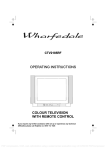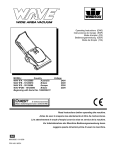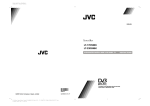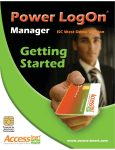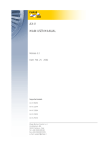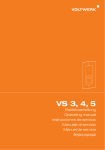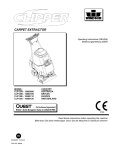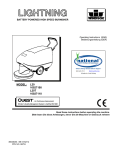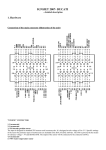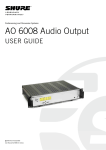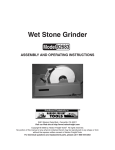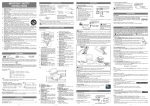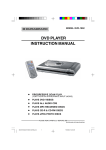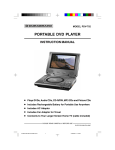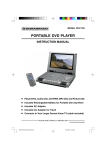Download Windsor Lightning Battery Burnisher 10027100 User's Manual
Transcript
LIGHTNING BATTERY POWERED HIGH SPEED BURNISHER Operating Instructions (ENG) Bedienungsanleitung (GER) MODEL: L20 10027100 L20T 10027110 Read these instructions before operating the machine. Bitte lesen Sie diese Anleitungen, bevor Sie die Maschine in Gebrauch nehmen 86038450 - AV 10/20/08 PRV NO. 98753 MACHINE DATA LOG MODEL _______________________________________ DATE OF PURCHASE __________________________ SERIAL NUMBER ______________________________ SALES REPRESENTATIVE # _____________________ Copyright 1995 Windsor Industries, Printed in USA YOUR DEALER Name: __________________________________________________________________________________________________ Address: _______________________________________________________________________________________________ Phone Number: _________________________________________________________________________________________ 2ENG 86038450 04/12/07 TABLE OF CONTENTS Machine Data Log. ...............................................2 Table of Contents.................................................3 HOW TO USE THIS MANUAL How to use this Manual........................................1-1 SAFETY Important Safety Instructions ...............................2-1 Hazard Intensity Level..........................................2-2 GROUP PARTS LIST Chassis/Drive Assembly Group. ..........................5-1 Deck Lift Mechanism. ...........................................5-3 Electrical Controls Group .....................................5-5 Handle Assembly .................................................5-7 Hood Group..........................................................5-9 Lift Linkage Group. ............................................. 5-11 Wiring Schematic (Non-traction). ....................... 5-13 Wiring Schematic (Traction). .............................. 5-15 Suggested Spare Parts ...................................... 5-18 Notes .................................................................. 5-19 OPERATIONS Components/Controls ..........................................3-1 Machine Operation...............................................3-2 Pre-Run Machine Inspection ............................3-2 Operating the Machine......................................3-2 Filter Bag. ..........................................................3-2 Dust Control Skirt ..............................................3-2 MAINTENANCE Battery Information...............................................4-1 Battery Connection...........................................4-1 Battery Maintenance. .......................................4-1 Battery Charging Procedure. ...........................4-1 Maintenance.........................................................4-2 Weekly Maintenance.........................................4-2 4 to 6 Month Maintenance ................................4-2 Ending Work Periods. .......................................4-2 Shunt Adjustments............................................4-2 Shaft Adjustment...............................................4-2 Lubrication............................................................4-3 Service Schedule .................................................4-3 Machine Troubleshooting.....................................4-4 86038450 04/12/07 3ENG HOW TO USE THIS MANUAL The PARTS LIST section contains assembled parts illustrations and corresponding parts list. The parts lists include a number of columns of information: This manual contains the following sections: - HOW TO USE THIS MANUAL SAFETY OPERATIONS MAINTENANCE PARTS LIST - The HOW TO USE THIS MANUAL section will tell you how to find important information for ordering correct repair parts. - Parts may be ordered from authorized dealers. When placing an order for parts, the machine model and machine serial number are important. Refer to the MACHINE DATA box which is filled out during the installation of your machine. The MACHINE DATA box is located on the inside of the front cover of this manual. - MODEL _____________________________________ - DATE OF PURCHASE ________________________ SERIAL NUMBER ____________________________ SALES REPRESENTATIVE # ___________________ Copyright 1995 Windsor Industries, Printed in USA The model and serial number of your machine is on the bottom back-end of the machine. The SAFETY section contains important information regarding hazard or unsafe practices of the machine. Levels of hazards is identified that could result in product or personal injury, or severe injury resulting in death. NOTE: If a service or option kit is installed on your machine, be sure to keep the KIT INSTRUCTIONS which came with the kit. It contains replacement parts numbers needed for ordering future parts. NOTE: The number on the lower left corner of the front cover is the part number for this manual. The OPERATIONS section is to familiarize the operator with the operation and function of the machine. The MAINTENANCE section contains preventive maintenance to keep the machine and its components in good working condition. They are listed in this general order: - Batteries Maintenance Shunt Adjustments Shaft Adjustment Lubrication Troubleshooting 1-1ENG REF – column refers to the reference number on the parts illustration. PART NO. – column lists the part number for the part. PRV NO. - reference number. QTY – column lists the quantity of the part used in that area of the machine. DESCRIPTION – column is a brief description of the part. SERIAL NO. FROM – column indicates the first machine the part number is applicable to. When the machine design has changed, this column will indicate serial number of applicable machine. The main illustration shows the most current design of the machine. The boxed illustrations show older designs. NOTES – column for information not noted by the other columns. 86038450 04/12/07 IMPORTANT SAFETY INSTRUCTIONS When using an battery powered appliance, basic precaution must always be followed, including the following: READ ALL INSTRUCTIONS BEFORE USING THIS MACHINE. To reduce the risk of fire, electric shock, or injury: Use only indoors. Do not use outdoors or expose to rain. Use only as described in this manual. Use only manufacturer’s recommended components and attachments. If the machine is not working properly, has been dropped, damaged, left outdoors, or dropped into water, return it to an authorized service center. Do not operate the machine with any openings blocked. Keep openings free of debris that may reduce airflow. This machine is not suitable for picking up hazardous dust. Machine can cause a fire when operating near flammable vapors or materials. Do not operate this machine near flammable fluids, dust or vapors. This machine is suitable for commercial use, for example in hotels, schools, hospitals, factories, shops and offices for more than normal housekeeping purposes. Maintenance and repairs must be done by qualified personnel. If foam or liquid comes out of machine, switch off immediately. Disconnect battery before cleaning or servicing. Before the machine is discarded, the batteries must be removed and properly disposed of. Make sure all warning and caution labels are legible and properly attached to the machine. During operation, attention shall be paid to other persons, especially children. Before use all covers and doors shall be put in the positions specified in the instructions. When leaving unattended, secure against unintentional movement. The machine shall only be operated by instructed and authorized persons. When leaving unattended, switch off or lock the main power switch to prevent unauthorized use. Only chemicals recommended by the manufacturer shall be used. This appliance has been designed for use with the brushes specified by the manufacturer. The fitting of other brushes may affect its safety. Do not use on surfaces having a gradient exceeding 2% unless the optional parking brake is installed on the machine. SAVE THESE INSTRUCTIONS 86038450 04/12/07 2-1ENG HAZARD INTENSITY LEVEL The following symbols are used throughout this guide as indicated in their descriptions: HAZARD INTENSITY LEVEL There are three levels of hazard intensity identified by signal words -WARNING and CAUTION and FOR SAFETY. The level of hazard intensity is determined by the following definitions: ! WARNING WARNING - Hazards or unsafe practices which COULD result in severe personal injury or death. ! CAUTION CAUTION - Hazards or unsafe practices which could result in minor personal injury or product or property damage. FOR SAFETY: To Identify actions which must be followed for safe operation of equipment. Report machine damage or faulty operation immediately. Do not use the machine if it is not in proper operating condition. Following is information that signals some potentially dangerous conditions to the operator or the equipment. Read this information carefully. Know when these conditions can exist. Locate all safety devices on the machine. Please take the necessary steps to train the machine operating personnel. FOR SAFETY: DO NOT OPERATE MACHINE: Unless Trained and Authorized. Unless Operation Guide is Read and understood. In Flammable or Explosive areas. In areas with possible falling objects. WHEN SERVICING MACHINE: Avoid moving parts. Do not wear loose clothing; jackets, shirts, or sleeves when working on the machine. Use Windsor approved replacement parts. ! WARNING Batteries emit hydrogen gas. Explosion or fire can result. Keep sparks and open flame away. Keep solution tank in raised position when charging. Keep sparks and flames away from the batteries. Do not smoke around batteries. ! WARNING Disconnect batteries before working on machine. Only qualified personnel should work inside machine. Always wear eye protection and protective clothing when working on or near batteries. Avoid skin contact with the acid contained in the batteries. ! WARNING Never allow metal to lie across battery tops. 2-2ENG 86038450 04/12/07 COMPONENTS/CONTROLS 13 12 1. Hour Meter. Records machine use time. 2. Battery Condition Light. Indicates the charge condition of batteries. 3. Main Power Switch. Turns On and Off the machine. 4. Pad Pressure Meter. “Green Area” indicates correct pad pressure range. 5. Burnishing Head Switch. Raises and lowers burnishing head. 6. 3 Amp Circuit Breaker. Thermal circuit breaker protects lift mechanism. Press to reset. 7. Main Handle. 8. Handle Adjustment Lever. 9. Breaker. 60 amp magnetic circuit breaker, protects pad driver motor. Press to reset. 10. Pad Motor Switch Bar. Raising bar turns on pad driver motor. 11. Pad Adjustment Knob. Rotating knob adjusts pad pressure. 12. Reverse Button (Traction model only). Propel bar must be squeezed and button pushed for reverse travel. 13. Speed Control (Traction model only). Knob rotated left to right for slow to fast speed. 14. 15 Amp Circuit Breaker (Traction model only). Protects transaxle. 86038450 04/12/07 3-1 ENG MACHINE OPERATION PRE-RUN MACHINE INSPECTION 1. Disconnect the battery charger. (See battery charging procedure). 2. Close the cover. 3. To raise the deck: Turn on the main power switch and press the burnishing head switch. 4. Turn or install a new burnishing pad as needed. NOTE: Pad lock has left hand threads. To loosen turn clockwise. FILTER BAG The filter bag is accessed under the cover. DUST CONTROL SKIRT Replace skirt (86007290 – PRV NO. 730017) when worn, torn, or damaged in any way that allows dust to escape. 5. Check wheels and other pivot points for proper lubrication. OPERATING THE MACHINE 1. If using a machine that is already set up, check to make sure the pad is properly installed. 2. Adjust the operating control handle to a comfortable position using the handle lock lever. 3. Turn on the main power switch. 4. Lower or raise deck by pressing burnishing head switch. 5. The pad motor will only run when the burnishing head is lowered to within 3 inches of the floor. 6. The drive controls are shown on page 3-1. 7. The pad pressure is adjusted using the knob at center of panel. The operator monitors the amp draw using the meter located on the control panel and ensures that the needle remains in the “green” operating range. (See page 3-1, #4 & 11). To prevent possible damage to the floor surface, always keep the machine moving while the pad is spinning. 8. When the pad motor switch bar is squeezed, the pad motor runs. 9. Return the machine to the battery charger when the battery light indicator light is amber. Do not operate machine when indicator is flashing red. 3-2ENG 86038450 04/12/07 BATTERY INFORMATION CHARGE BATTERIES IN A WELL-VENTILATED AREA WITH DECK DOWN AND COVER OPEN. 1. Use a 36 volt, 20 amp maximum output, D.C. charger that turns itself off, when batteries are fully charged. The charger must have a connector that matches the machine battery connection. 2. Read the instructions and warnings provided by the battery charger manufacturer. 3. Set the charger in a well-ventilated area on a level surface. Make sure cords will easily reach outlets on both machine and wall. 4. Connect charger to D.C. outlet on machine first. 5. Connect the A.C. power cord to properly grounded wall socket. NEVER MAKE THE A.C. CONNECTION FIRST, HAZARDOUS SPARKS MAY RESULT. BATTERY MAINTENANCE 1. When cleaning batteries use a solution of baking soda and water. (Do not allow cleaning fluid to enter inside battery cells.) 2. Keep a proper electrolyte level in battery cells. 3. Wipe down the battery tops at least once a week. If a cell should accidentally overflow, clean immediately. 4. Test battery condition with a hydrometer at least once a week. 6. After the batteries are completely charged disconnect the charger from the A.C. wall socket. 7. Once the charger is disconnected from the A.C. wall socket, it is safe to disconnect the charger from the machine. 8. When the batteries are fully charged, check the electrolyte level by removing, the caps on top of the batteries. If necessary fill the cells with distilled water as shown in the diagram below. Be careful not to overfill cells. 5. Ensure that all connections are tight and that all corrosion is removed. 6. Every 4 to 6 months remove batteries from the machine and clean the battery compartment. BATTERY CHARGING PROCEDURE Charge the batteries once the amber charge level light comes on. The amber light indicates that there is about 20% charge left in the batteries. Do not let the batteries completely drain before charging. Avoid charging the batteries before the amber light comes on. The machine will run for hours on fully charged, well maintained batteries. DO NOT SMOKE, HAVE OPEN FLAMES, OR SPARKS NEAR BATTERIES AT ANY TIME. WEAR EYE PROTECTION AND PROTECTIVE CLOTHING WHEN WORKING WITH BATTERIES. 86038450 04/12/07 4-1ENG MAINTENANCE WEEKLY MAINTENANCE 1. Use a hydrometer to check the condition of each battery cell. 2. Check battery cable clamps. Ensure clamps are tight on battery terminals. 3. Clean tops of batteries with a wet cloth and a solution of water and baking soda. Wipe battery tops dry after cleaning. 4. Check pad lock for looseness or damage. 5. Check filter and filter seals. Airflow should be unobstructed through filter. 6. Ensure that the pivot points and casters are properly lubricated. 7. Tighten any loose screws or nuts. 4 TO 6 MONTH MAINTENANCE 1. Remove batteries-clean battery tray and battery compartment. 2. Clean battery cable clamps and battery terminals. 3. Check the carbon motor brushes in the pad driver motor. 4. Use a vacuum to remove lint or dust build-up from motor windings. 5. Grease axles. AT THE END OF EACH WORK PERIOD: 1. Wipe down the exterior of the machine. 2. Lower the deck. 3. Open the cover. 4. Charge the batteries. (See battery charging procedure on page 4-1.) SHUNT ADJUSTMENT (Cont.) Check the amp range when nuisance tripping of the circuit breaker indicates that the shunt may be out of adjustment. 1. Connect a DC ampere meter to the positive battery lead. Running the machine with a pad, lower the pad to the floor until it is operating at 55-60 amps. 2. Moving the wire in the slot, adjust the pad pressure meter until the needle sets at the line between the green and red areas. 3. Check the other points indicated in the diagram above. The high end should trip the circuit breaker. Replace the pad pressure meter if the approximate amp ranges shown cannot be set. SHAFT ADJUSTMENT If shaft is replaced make sure it is adjusted correctly upon installation. SHUNT ADJUSTMENT This pad pressure meter adjustment is factory set. Over the course of time it may become necessary to adjust this setting using the slotted connection on the shunt. 5/8" 4-2ENG 86038450 04/12/07 LUBRICATION & SERVICE SCHEDULE The following symbols found throughout the manual indicate items requiring lubrication: APPLY GREASE USE SPRAY LUBRICANT ANTISEIZE USE ANTI-SEIZE WHEN REPAIRING PERMANENT (RED) THREAD LOCK TIGHT AXLE GREASING: 1-2 STROKES OF MOBILTEMP©78 OR COMPATIBLE CLAY-BASED OR CALCIUMBASED GREASE. NOTES: CAUTION: Do not use pressure washers to clean sealed gear boxes or bearings. If it becomes necessary to clean under machine with a pressure washer; Ensure all items noted are relubricated SERVICE SCHEDULE MAINTENANCE Check batteries after charging; add water if necessary Check pad wear to prevent buildup of chemicals Check pad driver system for damage Check bag/filter Check handles, switches, and knobs for damage Store with pad off the floor Check batteries for corrosion, cracks and evidence of overheating Check all bearings for noise Check skirt/bumpers for damage and replace as necessary Grease wheels and casters (if appropriate) Check potentiometer (speed control) for adjustment Check overall performance of machine DAILY MONTHLY * * * * * * * * * * * * 86038450 04/12/07 4-3ENG MACHINE TROUBLESHOOTING PROBLEM CAUSE SOLUTION No power to machine Poor Cable Connection Faulty Main Power Switch Pad motor won’t run Circuit breaker has tripped Actuator Safety Switch Faulty Relay Deck lift mechanism not working Circuit breaker has tripped Deck switch not working Deck actuator not working Handle switch not working Drive Controls Circuit breaker has tripped. Bad switch (es). Loose connection. Faulty potentiometer. Faulty drive control board. 4-4ENG Clean battery cable clamps of any corrosion and tighten. Test voltage at points G to B should be from 34 to 38 VDC. With the main power switch turned on, test voltage at points D to B should be from 34 to 38 VDC. If there is no voltage remove leads and check switch for continuity. Replace if necessary Reset circuit breaker (H). With main power on, pad lowered to floor, switch bar pulled up, test voltage at L (wire #2) to B (rear panel) should be 34 to 38 VDC. If not, check and adjust or replace safety switch as necessary. With main power on, pad lowered to floor and drive handle squeezed: Test voltage at points F to B and A to B should be from 34 to 38 VDC. When the relay is working it should make a clicking noise as the drive handle is squeezed. Replace relay if the test voltage F to B is OK. If test voltage F to B is not OK, check all wiring to pad motor relay. Reset circuit breaker (J). With main switch on, test voltage at C (5) to C (2) should be 34 to 38 VDC. If not check circuit breaker (J) and main power switch. If the test voltage at C (5) to C (2) is 34 to 38 VDC, the voltage at deck switch C (3) to C (6) should be 34 to 38 VDC when the deck switch is pressed to raise/lower the pad. If not, replace deck switch. If the deck switch tested OK, but the deck lift actuator still is not working, disconnect the white and black wires to actuator (K) and apply 36 VDC directly to actuator. If the actuator does not respond, replace actuator. Check power from E (wire #1) to B. Check switch continuity. Check if power at wire #26. If yes, but breaker has no power at wire 28 either reset breaker (Q) or replace. Check continuity at handle switch for non-traction model. Check continuity at propel switch or pad motor switch for traction model. Replace as necessary. Check all connections of propel circuit especially at M, N, P, R, S & T. Check transaxle connection at U. With the drive motor disconnected at V, test the output voltage to the drive motor. The output voltage at V should vary from 0 to 36V at R & S as the control lever is squeezed. Resistance of the potentiometer can be tested at the leads 4 & 1 found at the potentiometer T. The resistance should vary from 0-50K ohms. Voltage at T1 (P) to T2 (N) should be from 34 to 38VDC. If the voltage at T1 is good but the propel motor won't respond, and all the tests above have been done, replace the drive control board. 86038450 04/12/07 TROUBLESHOOTING. PROBLEM Drive controls cont. CAUSE SOLUTION Faulty motor. Loose Connection. Machine will not propel Bad Relay. Faulty Resistor. Squeeze the control lever and test the voltage at U (wire #27 & 28). When the output voltage varies with the control lever but the motor does not respond and all the tests above have been done, replace the motor. With main power on, test voltage at terminal 30 (X) on Relay should be 34 to 38 VDC. With switch on, check voltage to wire side of resistor (Y). Should be 34 to 38 VDC. With main power on, test voltage at terminal 87 (Z) should be 34 to 38 VDC. With main power on, test voltage at terminal 85 (AA) should be 22 to 26 VDC. 86038450 04/12/07 4-5ENG














